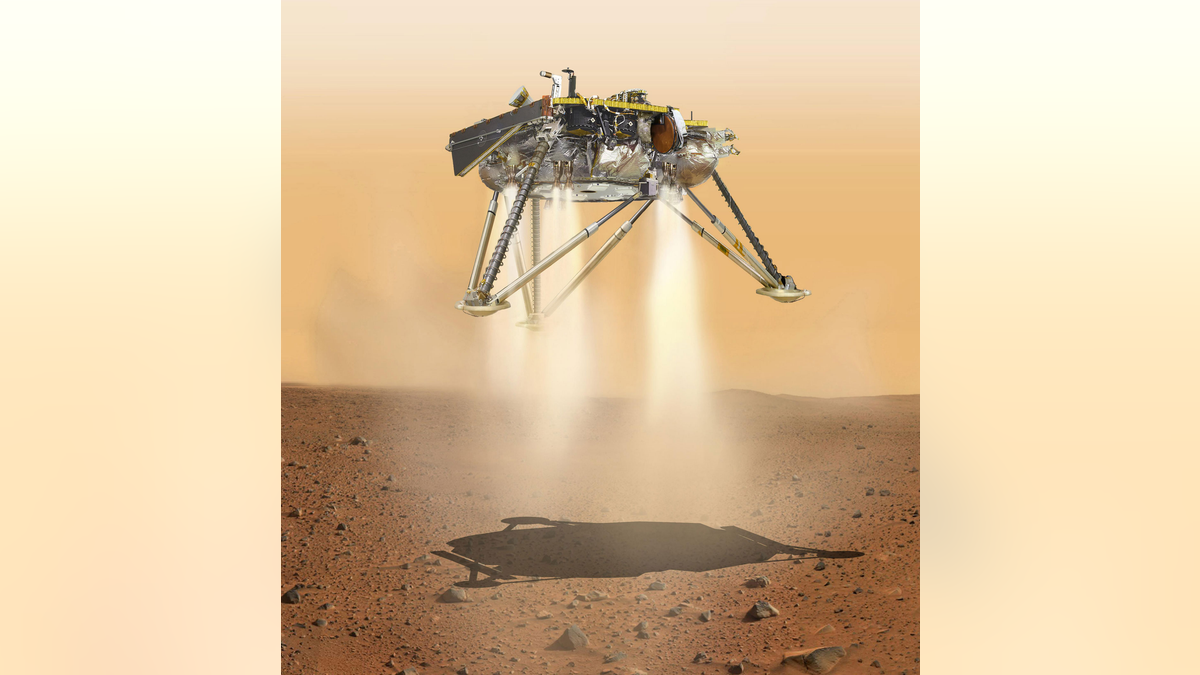
An artist's illustration showing NASA's InSight lander about to touch down on Mars. InSight's landing will take place on Nov. 26, 2018 (NASA/JPL-Caltech)
NASA has enjoyed a nice run of Mars-landing success lately, but that doesn't mean the agency is getting cocky ahead of next month's touchdown of its $850 million InSight mission.
NASA's twin Spirit and Opportunity rovers both aced their landings in January 2004, as did the Phoenix lander in May 2008 and the car-size Curiosity rover in August 2012. Regardless, InSight team members will doubtless be on tenterhooks as their spacecraft barrels into the Martian atmosphere at around 3 p.m. EDT (1900 GMT) on Nov. 26.
"Although we've done it before, landing on Mars is hard, and this mission is no different," Rob Manning, chief engineer at NASA's Jet Propulsion Laboratory in Pasadena, California, said in a newly released video. "It takes thousands of steps to go from the top of the atmosphere to the surface, and each one of them has to work perfectly to be a successful mission." [NASA's InSight Mars Lander: 10 Surprising Facts]
Manning walked viewers through some of the most important steps, starting with the separation of InSight's capsule from the "cruise stage" that has guided the lander through deep space since liftoff on May 5.
More From Space.com
This separation will occur 7 minutes before InSight hits the Martian atmosphere, if all goes according to plan. InSight must then realign itself precisely, so that it enters the atmosphere at a 12-degree angle.
"Any steeper, the vehicle will hit the thicker part of the atmosphere, and it will melt and burn up," Manning said. "Any shallower, the vehicle will bounce off the atmosphere of Mars."
As the InSight capsule plows through the air, its heat shield will experience temperatures well over 1,800 degrees Fahrenheit (1,000 degrees Celsius) — hot enough to melt steel, Manning said. After 2 minutes of such Martian air travel, InSight's speed will drop from 13,000 mph (20,900 km/h) to about 1,000 mph (1,600 km/h), he added.
It will then be time for InSight to deploy its big supersonic parachute. This milestone should occur at an altitude of about 10 miles (16 kilometers) above the Martian surface. Shortly thereafter, six pyrotechnic devices will fire simultaneously, jettisoning InSight's heat shield.
Ten seconds later, three more mini-explosions will deploy InSight's landing legs. About 1 minute after that, the lander will begin beaming out radar pulses to gauge its altitude and speed.
When InSight is just 1 mile (1.6 km) above the Martian surface, the lander will fall away from its parachute-toting backshell and light its descent engines, Manning said. InSight will have to rotate out of the way very quickly after it does this, to avoid being beaned by the parachute and backshell.
And then comes the landing itself, on a broad, flat plain just north of the Martian equator known as Elysium Plantitia.
"The last thing that has to happen is that, on the moment of contact, the engines have to shut down immediately," Manning said. "If they don't, the vehicle will tip over."
As this rundown indicates, all of this will happen in rapid succession: InSight's entire journey through the Martian air, from atmospheric entry to touchdown, will take just 6 minutes, NASA officials have said. (Curiosity team members dubbed that rover's entry, descent and landing sequence "7 minutes of terror," but InSight will get down a bit faster. And, unlike the heavier Curiosity, InSight won't need a sky crane.)
Then it will be time for the lander to get to work. InSight (whose name is short for "Interior Exploration using Seismic Investigations, Geodesy and Heat Transport") carries two main science instruments, a burrowing heat probe and a suite of superprecise seismometers.
The measurements made by this gear over about two Earth years will help mission team members better understand Mars' internal composition and structure, as well as how rocky planets form and evolve. InSight will also use its communications gear to perform a radio-science experiment, which should reveal key details about Mars' core, NASA officials have said.
InSight launched with twin, briefcase-size spacecraft, which together comprise a JPL demonstration mission known as Mars Cube One (MarCO). MarCO's main goal is to show that tiny cubesats can indeed explore interplanetary space.
The two spacecraft, known as MarCO-A and MarCO-B, will also attempt to beam home data from InSight during the latter's landing attempt on Nov. 26. But this is not a vital task; other NASA craft, such as the Mars Reconnaissance Orbiter, will do this work as well.
MarCO-A and MarCO-B will not attempt touchdowns of their own. They'll zoom past Mars on Nov. 26, and their mission will come to an end shortly thereafter.
Mike Wall's book about the search for alien life, " Out There ," will be published on Nov. 13 by Grand Central Publishing. Follow him on Twitter @michaeldwall . Follow us @Spacedotcom or Facebook . Originally published on Space.com .




















